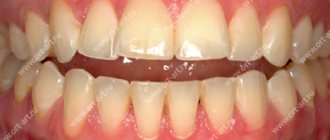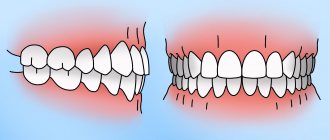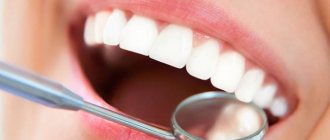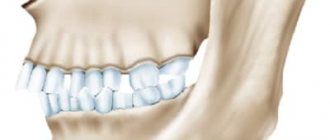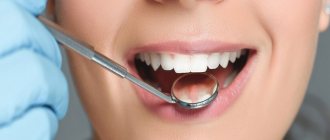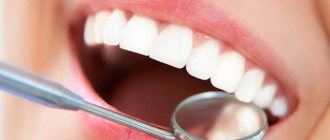Quite often in the practice of orthodontists, the following situation arises: they are approached by patients who have not thought about correcting their bite and sometimes did not even know that they had any problems, but were planning to install implants. But the implantologist refused to carry out treatment, referring him first to an orthodontist. Why is this happening?
The work of an implantologist and an orthodontist is connected, since the common goal is one - to bring the condition of the teeth as close as possible to ideal
To understand, you need to understand what is special about implants and how the bite affects them.
How are implants fundamentally different from other types of prosthetics?
Previously, prosthetics meant the installation of individual crowns or bridges. One crown can be installed on a dilapidated tooth, provided that its root is preserved. If a tooth is lost, you will have to grind down the nearest healthy teeth and install a bridge of crowns and an intermediate element on them.
A bridge consists only of crowns and an intermediate element; it does not replace the roots in any way
Although such prosthetics are still performed, it has disadvantages. Crowns functionally replace only the visible part of the tooth, allow chewing and return an attractive appearance to the smile, but do not restore the root of the tooth.
And when the roots of the teeth are lost, the jawbone gradually begins to thin out. The process of resorption (resorption) of bone tissue, which begins in all people after 35–40 years, occurs faster with tooth loss. The remaining teeth suffer from this.
The fundamental difference between implants is that they are installed in the bone, in place of the tooth root.
The most important stage in prosthetics is installation of the implant into the bone.
Thus, when chewing, the load is transferred to the implant, the jaw bone “responds” by supporting the renewal of bone tissue cells in this place. The functions of the tooth are fully restored, and there is no thinning of the jaw bone.
Therefore, implantation is in many cases the optimal method of prosthetics. But this is especially true for young people, those who are missing 1-2 teeth, and the rest are in good condition. It is implantation that will allow you to replace lost teeth in such a way that you can maintain the health of the remaining ones for many years.
Surgical correction of bite
Surgical intervention is carried out when orthopedic treatment using fixed/removable restorations is impossible; it makes it possible to quickly straighten the dentition.
Indications
:
- serious injuries and deformations of the dentofacial apparatus;
- open bite with obvious speech/mastication disturbances;
- facial asymmetry;
- crossbite;
- chin dysplasia;
- jaw anomalies - large lower jaw. If the doctor considers it inappropriate to compensate for intermaxillary discrepancies by advancing the upper jaw, you should agree to the operation - without a surgeon it will not be possible to reduce the large bone;
- underdeveloped lower jaw. It is impossible to increase it using orthodontic methods - the problem of size is solved not by position, but by size.
Stages of therapy
:
1. Diagnostics
. The presence of an abnormal bite is determined and its impact on the functioning of the dental system is assessed: a panoramic image of the jaw is taken, impressions are taken, a 3D model is created on which the condition of the teeth and the trajectory of movement of the lower/upper jaws are analyzed.
2. Sanitation of the oral cavity
. The dentist removes problematic units/roots, stone/plaque, fills carious cavities, and provides medical treatment for inflammatory gum diseases.
3. Installation of orthodontic structure
. A vestibular bracket is glued onto the central surface of the dental arch using adhesive composites, base rings are mounted, and a power arch is attached. The manipulations do not cause discomfort or pain and last 2-2.5 hours.
4. Recovery period
. The purpose of retention measures is to consolidate the obtained result. After the procedure of removing the system, it is necessary to use retainers - special mouth guards that hold the teeth in the correct position.
But what do braces have to do with it?
An important feature of implants is that when chewing they experience stress, and it is transferred to the internal part (pin). Therefore, it is very important to correctly calculate the location of the implant and its angle of inclination. The crown that will be installed on the implant after healing must be in the correct position relative to the remaining teeth so that there is no increased load when closing. Otherwise, the implant will not last long.
Each implant has its own installation angle, which is calculated individually
Preparation for implantation includes modeling the process in a special program. This is a very important stage on which the success of treatment depends. And it is at this stage that a problem may arise: if the bite is incorrect, implants most often cannot be installed, since it simply will not be possible to do it correctly.
Implantation is a complex and expensive procedure. In good clinics, doctors give a guarantee for the work performed, and this, as a rule, is not 1 year, but much longer. Therefore, an experienced doctor will not undertake treatment for a malocclusion, since he will not be able to guarantee a good result.
Sometimes bite problems are not visible to the person himself; for example, with a direct or deep bite, the teeth can be straight and the smile looks generally attractive. But still, this creates a problem for implantation.
Example: teeth are straight, but the occlusion is incorrect
And although treatment by an orthodontist will seriously delay the day when prosthetics can be performed (by at least several months), this stage cannot be skipped.
Preparation for orthodontic treatment
Before fixing the braces, the patient visited surgeon V.P. Alaverdov for the removal of a failed wisdom tooth.
Commentary by surgeon V.P. Alaverdova: “After the initial consultation with S.V. Zukor and subsequent comprehensive consultation with specialists, the patient was referred to me, and I carried out the first stage of the approved treatment plan. 1.8 tooth was removed. When removing a wisdom tooth, atraumatic techniques were used to preserve bone and gums. Two hemostatic sponges were placed in the socket and laser biostimulation was performed. The action of laser radiation sterilizes the hole, preventing possible complications and accelerating tissue healing. The removal was successful, healing without complications.”
Hygienist E.P. Smirnova performed Air Flow teeth cleaning, ultrasonic tartar removal, and minor gum treatment. This stage is performed free of charge as part of a promotion for patients undergoing complex orthodontic treatment.
Endodontist R.A. Akopov treated tooth 1.1 (front upper tooth on the right). Treatment of tooth canals, as well as placement of fillings, is performed using a dental microscope. Root canal treatment uses high-tech instruments to penetrate the crooked, narrow canals of teeth and provide the most thorough treatment possible. Treatment of canals under a microscope provides a full guarantee of quality and a long-term prognosis, which is important when installing expensive denture structures.
Commentary by endodontist R.A. Akopova: “The patient was referred by the chief physician S.V. Tsukor for revision of tooth 1.1. After diagnostics, including computed tomography, a decision was made to re-treat tooth 1.1, since an inflammatory process was observed behind the apex of the tooth. Retreatment used a microscope, nickel-titanium rotating instruments, and a self-adapting SAF file. The treatment was successful."
How to quickly and easily carry out treatment before implantation
Those who have not previously thought about treatment with an orthodontist are not motivated to wear braces, and this is understandable. But now, thanks to aligners, it is possible to undergo treatment in a short time. In addition, such an orthodontic system is invisible to others. Aligners are superior to braces in most important parameters and are best suited for preparation for implantation, since treatment with them is quick.
Preparation for implantation can take from several months to a year, depending on the initial situation. But such comprehensive treatment will bring benefits in the future, since with a correct bite it is easier to maintain healthy teeth.
It is better to correct the bite as early as possible. But if this does not work out, then you can contact an orthodontist at any age, even at 45–50 years old and later (nowadays older patients are not uncommon).
Material
The service life and characteristics of the product depend on the material of manufacture. Zirconium oxide structures are characterized by increased strength. Even titanium is inferior to this material in terms of strength.
Products are created from stainless steel, metal alloys, plastics, dental ceramics and combinations of materials.
Steel
Durable, technologically advanced and cheap material. Dental sockets are manufactured by stamping in laboratories or factories. The steel cap is open-forged to a configuration that matches the shape of the unit being restored. A coating of titanium nitride and a layer of ceramic or plastic is applied on top.
Due to low aesthetics, crowns are used on chewing elements.
Metal alloys
Combinations of cobalt, silver, titanium and gold are used. Products from refractory compositions are made by stamping, and from low-melting ones, casting and stamping technologies are used.
Prostheses made of noble metals are characterized by high biocompatibility with body tissues and long-lasting use.
Metal ceramics
A layer of ceramic is applied to the metal base, and the structure is fired in a kiln. The products combine the strength of metal and the aesthetics of ceramic composition.
Ceramics
Metal-free products are made from ceramics. They are highly aesthetic. Almost invisible in the oral cavity. Models made from durable types of dental ceramics are made using sintering, casting or sawing technology.
Metal-plastic
Models consisting of a metal base and a plastic layer. They are distinguished by functionality and aesthetics.
Stages of prosthetics
The procedure requires several visits to the dentist. Initially, the patient is examined, interviewed and examined. The doctor develops a treatment plan. The unit is then prepared. The dentist removes a layer of enamel from the tooth equal to the thickness of the crown wall. Local anesthesia is performed.
An impression of the dentition is taken and sent to a dental laboratory. The dental technician chooses the production technology depending on the type of prosthetic structure.
After making the prosthesis, the doctor fits the structure. Then grinding and polishing is carried out.
The prosthesis is fixed with cement. The stump and surface are first degreased and disinfected. At the last stage, the dentist removes excess cement.
Features of care
Crowns do not require special care. It is enough to observe daily oral hygiene and a gentle diet. It is recommended to get rid of the habit of smoking cigarettes.
Ceramic inlay - microinsert that replaces a filling
As you know, before filling a tooth affected by caries, the doctor first excises its non-viable tissue. Therefore, in case of secondary caries, when the filling has to be re-placed, due to the significant size of the cavity, the tooth is already practically destroyed. The patient is recommended to undergo depulpation and cover it with a crown.
Recurrence of caries occurs due to the lack of proper sealing between the walls of the tooth and the composite filling, which decreases in volume during polymerization. The ceramic inlay is free of this drawback; it is manufactured individually with high precision and therefore fits tightly to the tooth. The ceramic material of the inlay does not shrink and does not change color or shape during use.
Microprosthetics with inlays is performed on teeth whose defects make up up to 30% of the volume of their coronal part, and allows you to create exact copies of teeth with the correct shape of the chewing surface.
What consequences are possible?
In some cases, a specialist may refuse to correct a bite with braces due to certain complications:
- The material from which the crown is made may not withstand constant pressure and the outer layers may crumble or even completely.
- The root of the tooth may move in the wrong direction.
- After aligning the units, the artificial tooth may not look aesthetically pleasing.
Each case is individual, so the final decision on the installation of orthodontic structures is made by the doctor.
Basis of construction
Determining the height of the bite is based on assessing the distance between the jaws when fully closed, which makes it possible to determine the correct development and location of the elements of the dentition. The presence of defects leads to a displacement of the main anatomical components of the jaw region - the lips recede, the facial folds increase, the chin protrudes, and the height of the lower part of the face decreases. Increasing the height of the bite restores aesthetics and facilitates further therapeutic measures.
Stage II - tooth implantation
After removing the braces, implant surgeon V.P. Alaverdov installed an Astra Tech dental implant for the patient. The operation lasted 30 minutes and was performed under sedation (in medical sleep). Healing took several months.
The fixed orthotic remains on the teeth until the final dental prosthetics. The dimensions of the orthotic will be harmoniously distributed between the antagonist teeth. Crowns on the teeth will fix the correct position of the bite.
Stage IV - dental prosthetics
Prosthetics on an implant, as well as prosthetics of teeth in the lateral sections above and below in a physiological and stable musculoskeletal position of the lower jaw, created all the prerequisites for the correct functioning of the TMJ. Crowns are installed on the teeth on a zirconium dioxide frame.
After dental prosthetics:
Consultation with specialists
At a joint consultation, an orthopedist, an orthodontist and a neuromuscular dentist explained to the patient that the problem could not be solved without serious bite correction. It is important to achieve not only an aesthetic result, but also to maintain the health of the temporomandibular joints. Prosthetics for worn teeth in a habitual bite can cause additional discomfort, headaches, and increased pain in the TMJ. Prosthetics will not be durable; crowns will chip in the same way as teeth, since the source of the problem is the incorrect position of the lower jaw relative to the skull and increased tension in the TMJ. Without correcting the incorrect position of the jaw, no measures will produce results. Therefore, prosthetics must be performed in the correct bite (correct does not mean habitual).
